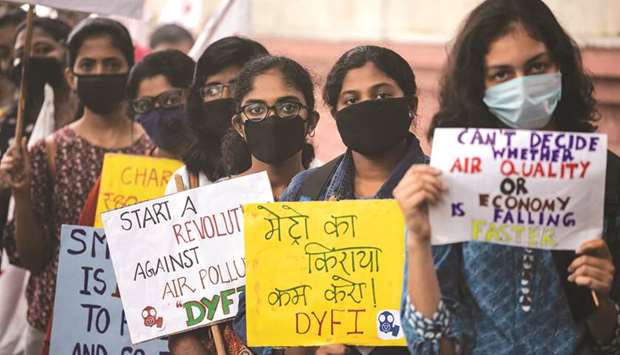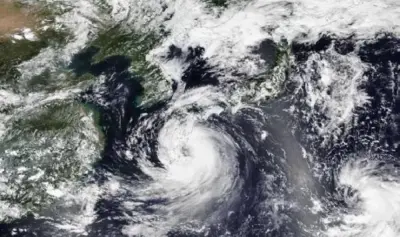New Delhi was enveloped in heavy, toxic smog yesterday – the worst levels in recent years – with flights diverted or delayed as politicians blamed each other for failing to tackle the crisis.
Every winter, the city of 20mn people is blanketed by a poisonous smog of car fumes, industrial emissions and smoke from stubble burning at farms in neighbouring states.
Concentrations of particles measuring less than 2.5 microns hit the highest level of this season, exacerbated by light rains late Saturday, India’s state-run System of Air Quality Weather Forecasting and Research (SAFAR) said.
The reading for pollutants in the atmosphere hit 810 micrograms per cubic metre yesterday morning, beyond the “hazardous” zone according to the US embassy in Delhi, which independently monitors pollution levels.
The recommended World Health Organisation safe daily maximum is 25.
“Pollution has reached unbearable levels,” Delhi Chief Minister Arvind Kejriwal tweeted yesterday.
Visibility was so poor that major carriers Air India and Vistara said flights were being delayed or diverted to and from Delhi’s airports.
“It’s actually scary – you can’t see things in front of you,” protester Jaivipra said at a rally in Delhi yesterday calling for politicians to do more to curb pollution.
Nurses at the demonstration said they were seeing more people suffering from respiratory problems.
“Patients are coming with more lung and respiratory diseases, like more (are) affected with asthma,” Reshma C M said.
The conditions sparked a blame game between state and federal politicians over who was responsible for the conditions, which authorities said on Friday reached “emergency” levels.
In a tweet last week, Kejriwal called on the state governments of neighbouring Punjab and Haryana to take action.
“Delhi has turned into a gas chamber due to smoke from crop burning in neighbouring states,” he tweeted.
Federal Environment Minister Prakash Javadekar accused Kejriwal of politicising the issue and presenting the two states “in a bad light and as villains”.
Schools in Delhi have already been ordered closed until tomorrow, and construction halted.
From today there will be an odd/even car licence plate scheme to cut traffic.
Global non-profit Vital Strategies’ senior vice president for environmental health, Daniel Kass, said while temporary curbs were helpful, they had limited impact over time.
“They are insufficient to address the most important aspect of air pollution, which is what people live with day-to-day,” Kass said.
He said a range of measures needed to be imposed at local and national levels for air quality to improve.
Apart from changing agricultural practices, he said the measures should include more public transport investment, emission controls on two-wheelers, switching electricity generation sources, and accelerating the conversion of home-heating from charcoal to natural gas.
Sachin Taparia, head of Local Circles, a Delhi-based private consultancy that conducts surveys on government policies and programmes, said “Delhi has turned into a gas chamber as the pollution levels hit the ‘severe+’ category.”
A survey of 17,000 people in the Delhi region by his consultancy found that 40% want to get out of the Delhi region because of the failure to control pollution.
The Supreme Court is likely to hear today a petition looking for ways to make state governments to take tougher action against farmers to curb the stubble-burning. Politicians have been reluctant to upset their farming constituencies.
According to SAFAR, satellite pictures had captured more than 3,000 incidents of stubble burning last week in neighbouring states, contributing to 44% of Delhi’s pollution.
Last year, a UN report found 14 of the world’s 15 most polluted cities were in India, with one US study saying it kills a million people prematurely every year.

Protesters wearing face masks due to heavy smog conditions take part in a demonstration demanding the government take measures to curb air pollution, in New Delhi yesterday.


